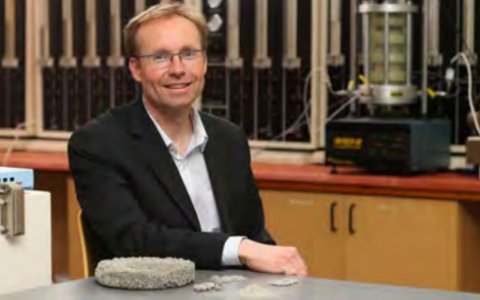Containing contamination: Dr. Craig Lake (BEng (TUNS)’95)
As published in the spring 2016 issue of Dalhousie’s Engineering Magazine
Craig Lake knows his last name is kind of appropriate, given that his research is focused on preventing contaminated soil and water from reaching clean environmental areas. “I get that a lot,” he says, laughing. “But I’ve always had this fascination with how our society interacts with our outdoor environments.”
is kind of appropriate, given that his research is focused on preventing contaminated soil and water from reaching clean environmental areas. “I get that a lot,” he says, laughing. “But I’ve always had this fascination with how our society interacts with our outdoor environments.”
Wide-reaching research
For the past 20 years, this Department of Civil and Resource Engineering professor has been exploring that interaction in detail, specifically which materials provide the best possible containment solutions. Although he is relatively modest when it comes to his achievements, the fact that his work is referenced multiple times in a state-of-the-art review of current knowledge about containment solutions commissioned by, amongst others, the U.S. Environmental Protection Agency gives you some idea of its significance. His research is also extensively used in the design of landfill systems to ensure contaminants are kept in check.
“I’m reticent to talk about myself in terms of impact,” he says. “I think the problems that we work on as researchers are very specific and no one person could ever answer all the questions.”
Advancing understanding
Even so, Lake’s research is advancing our understanding of how materials such as cement and geosynthetic clay liners can protect our soil and water. He has worked extensively with stakeholders on all sides of the issue, from industries that are decommissioning properties to regulators tasked with making decisions about best practices for treating contamination.
Given that wide-ranging experience, you might wonder what his key finding has been over the course of his research. “There’s no silver bullet,” Lake replies. “Each material used in a landfill or other containment application has its strengths and weaknesses. The key is to understand how these engineered containment materials “work” when in contact with different contaminants, and then use a combination of computer models and engineering judgement to assess their appropriateness for each individual situation.”
Reusing waste material
Meanwhile, Lake continues to draw on his extensive knowledge for a secondary line of research on how waste material can be used as a beneficial product in construction.
“I’ve been working with a company in the UK that manufactures aggregates out of waste materials. There are certain benefits to using these aggregates because they tend to be cheaper and lighter, and they can be marketed as carbon-neutral, which is a big trend over there. So this whole idea of creating useful products from waste material really appeals to me.”
Training entrepreneurial engineers
It’s one of several research areas that Lake would like to explore further. As excited as he is about the possibilities for our environment, he says the most rewarding part of his work is the opportunity to mentor students who will build on his breakthroughs.
“To see students go on to apply the skills they learn at Dalhousie as consultants, regulators and entrepreneurs, that’s what excites me. This research is helping to create a whole new generation that will apply their knowledge to addressing these issues. That’s the essence of engineering.”